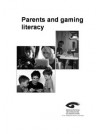The Office of Film and Literature Classification commissioned University of Waikato researcher Dr Gareth Schott to investigate the degree of parents' gaming literacy, and any connections between this literacy and their perceptions of violence in games. The research also looked at their perceptions of the effectiveness of the classification system for games. A key finding of this research is the importance of providing parents with information in order to increase their awareness and understanding of the games their children are playing, by helping them to learn about games as well as about the classification process.
Methodology
This research employed qualitative methods with a small sample of twenty participants in order to address, in depth, the degree of game literacy possessed by parents. While it is useful to collect general perceptions of, and attitudes towards, interactive game texts, this research sought to engage parents in the activation of selected game texts in order to achieve a discussion of games based on direct experience. Large-scale, self-report methodologies may offer generalisability as to the general population’s stance on games and understanding of classification, but they also work on the assumption that research participants possess a preformed set of ideas, thoughts and beliefs (Gubrium & Holstein 2003) that can be extracted by simply asking questions and recording answers (Cicourel 1964). This has the effect of subordinating the interpretive activity of participants solely in relation to the substance of what they report. To counter this, our research sought to assess general viewpoints on, and preconceptions of, the game medium against observed experiences and immediate and spontaneous reactions to gameplay.
In adding observation of gameplay to the methodology, it was possible to ensure that discussions with participants would be based on witnessed ‘performative involvement’, evident in the execution of decisions or response to the conditions of the game. This approach sought to examine the way the features of the game itself shaped the player’s understanding of it. In doing so, it was also possible to assess the level of communicative competency and moving image literacy exhibited by parents who, in turn, may determine the degree of tolerance they possess for games, or pleasure they are able to gain from them (Burn & Parker 2001). It was also the intention that by observing patterns of activity within a game, it would be possible to examine how participants might respond to, but also become more knowledgeable about, the resources that are made available within games (in-game objects, actors and spaces), and how they are manipulated.
Key Results
Many participants felt that they were able to judge the maturity of their son/daughter in relation to deciding whether a game was suitable for them. However, many of the parents who participated in this research said they were not involved in the purchasing or acquisition of age-restricted video games for their dependants, instead responding to games once they were present in the home. This highlights the importance of increasing awareness around the meaning of the classifications which are assigned to video games, particularly age-restricted classifications. It also reinforces the ‘gatekeeper’ role of retail staff in relation to age-restricted video games.
All but two participants played the video game Grand Theft Auto IV, and the report focuses on discussion of their responses to that game. Two participants played ODST: Halo 3, which was originally selected for the purposes of this research by the Classification Office to be a contrasting game experience to Grand Theft Auto IV, but which proved too difficult for inexperienced players to familiarise themselves with in the allotted timeframe.
Interviews were conducted before and after the gaming session to ascertain and evaluate the impact (if any) that playing an R18 video game had on participants’ perceptions of violent video games. The majority of participants expressed their surprise at enjoying playing the game (Grand Theft Auto IV).
Significantly, the research highlighted the importance of the context in which violence is elicited in a video game. Participants found their character in complex situations, where committing acts of violence was sometimes necessary in order to survive. The game’s strong narrative also helped to contextualise the violence and enabled some participants to identify with parts of the game’s story. Participants noted that their experiences of playing the game did not match their preconceptions of a highly violent ‘murder-simulator’ – preconceptions which had largely been shaped by media reports of the game. For most participants, it prompted a radical re-evaluation of the game and of what may be contained within an R18 classified game.
Participants generally showed uncertainty regarding the reasons for the game’s R18 classification, as well as a lack of awareness of how video game classification operates. However, after playing the game, most participants suggested that it was the sophistication of the game that gave it its classification, with participants highlighting the maturity needed to be able to comprehend the irony, satire, and intertextual references employed by the game’s developers.
A key finding of this research is the importance of providing parents with information in order to increase their awareness and understanding of the video games their dependants are engaging with, by helping them to learn about games as well as about the classification process.

